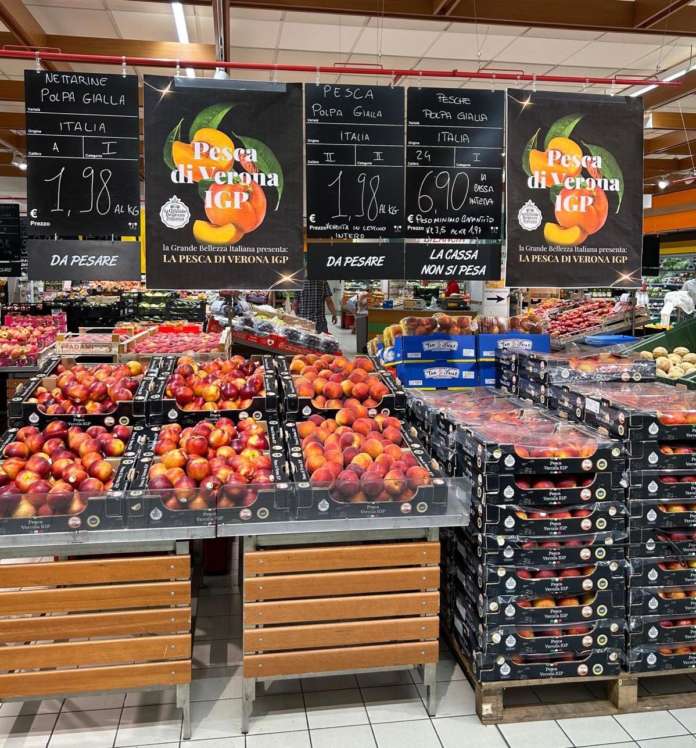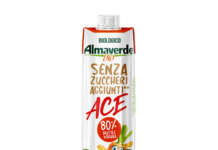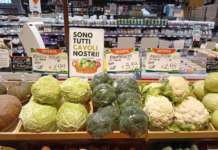Sono stati 26.800 i chili di pesca di Verona Igp venduti in dal 27 luglio al 28 agosto 2023 presso un’insegna veneta della gdo. Numeri che ne confermano la rilevanza. Leonardo Odorizzi socio della rete La Grande Bellezza Italiana che distribuisce la Pesca Igp di Verona oltre ad altre importanti produzioni Igp ha le idee chiare: “Dobbiamo dare valore al prodotto e lo possiamo fare solo mettendo al centro la nostra italianità. Il nostro valore aggiunto è il territorio, solo così possiamo competere con le produzioni estere e dare la giusta remunerazione al produttore”. Anche Antonio Troiani del Gruppo Rossetto, la catena che ha registrato le performance commerciali descritte sopra, si dimostra soddisfatto per il progetto che promuove la commercializzazione del frutto: “I numeri ci hanno dato ragione sulle potenzialità di commercializzazione della pesca di Verona Igp. Ora è giunto il momento di fare volumi e dare continuità produttiva ad un prodotto che è ricercato sui banchi di vendita dal nostro consumatore. Se si riesca a garantire, per tutta la stagione, la qualità che abbiamo potuto assaporare l’anno scorso, sono certo che il prodotto potrà ritagliarsi un ruolo da protagonista non solo in Veneto ma anche in altre zone d’Italia così come all’estero conclude Troiani”. Anche Alessandro Mion dei Supermercati Migross conferma la volontà di puntare sui prodotti del territorio anche per ragioni logistiche di freschezza: ”La nostra catena privilegia il prodotto locale perché è il nostro consumatore a volerlo. Il progetto della pesca di Verona Igp incontra perfettamente le nostre esigenze, afferma Mion. Grazie al riconoscimento della denominazione (avvenuta nel 2010 e ripartita nel 2023), al valore attribuito al territorio e alla volontà dei produttori di applicare il disciplinare e il sistema di controlli, il settore ha tutte le carte in regola per riacquistare una competitività che sembrava perduta.
Annata in chiaroscuro per le pesche, percoche e nettarine, quella appena trascorsa. Alla buona qualità dei frutti si è contrapposto un calo dei raccolti, causato dagli eventi climatici che hanno contraddistinto gli inizi di stagione con gelate tardive e maltempo. Secondo i dati diffusi dal Centro Servizi Ortofrutticoli (Cso) la produzione italiana, si è fermata a quota 900 mila tonnellate, subendo una flessione di circa il 10% su base annua e di circa il 30% rispetto ai dati medi dell’ultimo quinquennio. Per la stagione entrante è ancora difficile fare previsioni ma i progetti in atto, sia in termini varietali che promozionali, fanno ben sperare per il futuro.
acquisto differenziate
Sebbene le due specie di frutto siano spesso confuse o parificate, è nell’ambito dell’acquisto che si possono osservare le differenze riguardo alle scelte d’acquisto del consumatore. Le pesche sono quelle che detengono un indice di penetrazione più stabile nel tempo, con oscillazioni di massimo 3 punti percentuale, compresi fra il 65 ed il 67% delle famiglie. Per quanto riguarda i consumi di pesche, nel 2021 ciascun nucleo ne ha consumato mediamente 7,89 kg, contro gli 8,70 del 2020 e i 10,71 kg del 2019. Situazione diversa per le nettarine che nell’ultimo quadriennio si posizionano mediamente al 49% di penetrazione, in calo rispetto al passato. Per quanto riguarda il consumo in Italia, le pesche vanno bene nelle regioni del Nord Ovest dove nel 2021 si è raggiunto il 71%, di penetrazione, mentre le nettarine trovano maggiore affezione nelle famiglie residenti nel Nord Est. Il prodotto piace meno nel Sud Italia, mentre al Centro e in Sardegna (67%) i consumi medi sono ancora sostenuti (8,77 kg all’anno).
Per quanto riguarda i canali di acquisto il prodotto transita principalmente attraverso i canali della gdo. Nel 2021 su un totale di 133 mila tonnellate di pesche acquistate, il 64% è passato nei punti di vendita della distribuzione organizzata, in termini assoluti si tratta di oltre 85 mila tonnellate.
Di queste la quota di maggioranza è di competenza dei supermercati con 52 mila tonnellate (39% sul totale pesche), seguiti dai discount a 16 mila tonnellate e dagli ipermercati a 15 mila tonnellate. Nell’ambito dei canali tradizionali per le pesche sia fruttivendoli che ambulanti ricoprono il 16% del totale con poco meno di 22 mila tonnellate i primi e 20 mila per i secondi. Il prodotto confezionato pesa per il 19% (anno 2021), rispetto allo sfuso, con un trend in aumento costante sulla serie storica. Per quanto riguarda prodotto biologico non si registrano particolari performance. Le pesche non passano nel carrello della spesa delle famiglie italiane (volumi -11% rispetto al 2020 passando da 13 a 11 mila tonnellate) e così anche per le nettarine (6,2% del totale con un ammontare in volume di 4.358 tonnellate).
L’attività di breeding e le sfide per il futuro
Da quando il miglioramento genetico ha esordito nel comparto, più di 120 anni fa, la gamma di tipologie di frutto disponibili per il consumatore si è notevolmente ampliata e diversificata: pesche e nettarine (inizialmente denominate peschenoci, a causa della piccola pezzatura e del colore poco attraente), polpa tenera e succosa o soda e croccante, forma rotonda o piatta, sapore tradizionale o dolce, per citare solo le più importanti.
Dal 1980, il rinnovo varietale procede a ritmi particolarmente intensi, almeno per il mercato fresco, tanto che in soli trentacinque anni sono state complessivamente create circa 3.200 cultivar, distinte tra pesche (59%), nettarine (36%) e percoche (5%).
I caratteri maggiormente interessati dall’attività di breeding sono legati all’aspetto del frutto, inteso come regolarità di forma, pezzatura e colore, qualità gustativa, che varia dal dolce all’acidulo, al calendario di raccolta. Questa intensa attività ha generato anche tanta confusione sul mercato, tanto che il consumatore oggi si limita ancora a distinguere il prodotto solo dal colore. Per sfruttare le potenzialità ancora inesplorate del settore, le sfide saranno basate sull’applicazione di corrette politiche di segmentazione del mercato e su campagne di informazione del consumatore capaci di spiegare requisiti, territorialità e qualità del prodotto. Sul fronte varietale invece si apre la partita delle drupacee piatte che piacciono al consumatore per il sapore ‘semidolce’ e per la praticità d’uso.
PGI Peach from Verona: the product appreciated by large-scale distribution
26,800 kilos of Verona PGI peaches were sold from 27th July to 28th August 2023 at a Venetian retailer. These numbers confirm the relevance of the product. Leonardo Odorizzi, member of ‘La Grande Bellezza Italiana’ network, which distributes PGI Peach of Verona as well as other important PGI productions, has clear ideas: ‘We must give value to the product and we can only do this by putting our Italian identity at the centre. Our added value is the territory, only in this way can we compete with foreign productions and give the right remuneration to the producer’. Even Antonio Troiani of Rossetto Group, the chain that recorded the commercial performances described above, is satisfied with the project that promotes the marketing of PGI Peach of Verona: ‘The numbers proved us right about the marketing potential of PGI Peach from Verona. Now the time has come to increase volumes and give production continuity to a product that is sought after by our consumers on the sales counters. If we can guarantee, throughout the season, the quality that we were able to savour last year, I am sure that the product will be able to carve out a leading role not only in Veneto, but also in other areas of Italy as well as abroad’. Alessandro Mion of Migross Supermarkets, too, confirms the will to focus on local products also for logistical reasons of freshness: ‘Our chain favours local products, because our consumers want them. The project concerning PGI Peach from Verona meets our needs perfectly. Thanks to the recognition of the denomination (it occurred in 2010 and restarted in 2023), value attributed to the territory, and producers’ willingness to apply the specifications and the control system, this sector has everything it takes to regain a competitiveness that seemed lost’.
A reflourishing is needed for peaches and nectarines
To revive stone fruit production, we look at how to exploit the untapped potential of the sector
Last year, ups and downs were recorded for peaches, percoche peaches, and nectarines. The good quality of the fruit was offset by a decline in harvests, caused by climatic events at the beginning of the season, with late frosts and bad weather. According to data released by the Fruit and Vegetable Services Centre (Centro Servizi Ortofrutticoli, Cso), Italian production stopped at 900 thousand tonnes, suffering a decline by around 10% on an annual basis and around 30% compared to the average data of the last five years. It is still difficult to make predictions for the upcoming season, but the ongoing projects, both in varietal and promotional terms, give hope for the future.
Differentiated purchasing choices
Although the two species of fruit are often confused or equated, it is in the context of purchasing that differences can be observed in terms of consumer’s purchasing choices. Peaches are those that have a more stable penetration index over time, with fluctuations of a maximum of 3 percentage points, between 65 and 67% of families. As regards the consumption of peaches, in 2021 each household consumed on average 7.89kg, compared to 8.70kg in 2020 and 10.71kg in 2019. The situation was different for nectarines, which in the last four years are positioned on average at 49% penetration, decreasing compared to the past. As regards consumption in Italy, peaches do well in the regions of the North West, where 71% penetration was reached in 2021, while nectarines find greater affection among families residing in the North East. This product is less popular in Southern Italy, while it is appreciated in Central Italy and Sardinia (67%), where average consumption is still high (8.77kg per year). As regards purchasing channels, the product mainly passes through large-scale retail channels. In 2021, out of a total of 133 thousand tonnes of peaches purchased, 64% passed through organized distribution stores, in absolute terms we are talking about 85 thousand tonnes. The majority share of this quantity belongs to supermarkets with 52 thousand tonnes (39% of total peaches), followed by discount stores with 16 thousand tonnes and hypermarkets with 15 thousand tonnes. Within the traditional channels for peaches, both greengrocers and street vendors cover 16% of the total, with just under 22 thousand tonnes for the former and 20 thousand for the latter. The packaged products concern 19% (year 2021), compared to the bulk products, with a constantly increasing trend over the historical series. As regards the organic product, no particular performances were recorded. Peaches do not enter the shopping carts of Italian families (volumes -11% compared to 2020, going from 13 to 11 thousand tonnes) and the same is true for nectarines (6.2% of the total, with a volume amount of 4,358 tonnes).
Breeding activity and challenges for the future
Since genetic improvement made its debut in the sector, more than 120 years ago, the range of types of fruit available to the consumer has significantly expanded and diversified: peaches and nectarines (initially called peaches nut, due to their small size and unattractive colour), tender and juicy or firm and crunchy pulp, round or flat shape, traditional or sweet flavour, to name just the most important ones. Since 1980, varietal renewal has proceeded at a particularly intense pace, at least for the fresh market, so much so that in just thirty-five years a total of around 3,200 cultivars have been created, divided into peaches (59%), nectarines (36%) and percoche peaches (5%). The characteristics most affected by breeding activity are linked to the appearance of the fruit, understood as regularity of shape, size and colour, taste quality, which varies from sweet to sour, and harvesting calendar. This intense activity has also generated a lot of confusion on the market, so much so that consumers today are still limited to distinguishing the product only by colour.
To exploit the still unexplored potential of the sector, the challenges will be based on the application of correct policies of market segmentation and consumer information campaigns capable of explaining product requirements, territoriality, and quality. On the varietal front, however, the game of flat stone fruit opens up. Consumers appreciate them for their ‘semi-sweet’ flavour and practicality of use.










